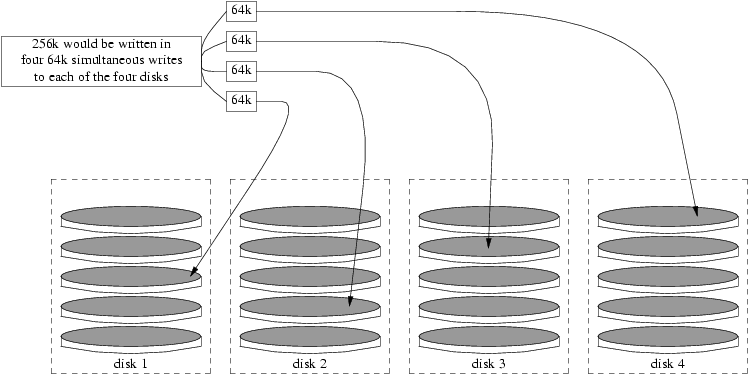Written by Tom Rhodes and Murray
Stokely.
Striping is a method used to combine several disk drives into a single volume. In many
cases, this is done through the use of hardware controllers. The GEOM disk subsystem
provides software support for RAID0, also known as
disk striping.
In a RAID0 system, data are split up in blocks that
get written across all the drives in the array. Instead of having to wait on the system
to write 256k to one disk, a RAID0 system can
simultaneously write 64k to each of four different disks, offering superior I/O
performance. This performance can be enhanced further by using multiple disk
controllers.
Each disk in a RAID0 stripe must be of the same
size, since I/O requests are interleaved to read or write to multiple disks in
parallel.

Creating a stripe of unformatted ATA disks
-
Load the geom_stripe module:
# kldload geom_stripe
-
Ensure that a suitable mount point exists. If this volume will become a root
partition, then temporarily use another mount point such as /mnt:
# mkdir /mnt
-
Determine the device names for the disks which will be striped, and create the new
stripe device. For example, to stripe two unused and unpartitioned ATA disks, for example /dev/ad2 and
/dev/ad3:
# gstripe label -v st0 /dev/ad2 /dev/ad3
-
Write a standard label, also known as a partition table, on the new volume and install
the default bootstrap code:
# bsdlabel -wB /dev/stripe/st0
-
This process should have created two other devices in the /dev/stripe directory in addition to the st0 device. Those include st0a and
st0c. At this point a file system may be created on the st0a device with the newfs utility:
# newfs -U /dev/stripe/st0a
Many numbers will glide across the screen, and after a few seconds, the process will
be complete. The volume has been created and is ready to be mounted.
To manually mount the created disk stripe:
# mount /dev/stripe/st0a /mnt
To mount this striped file system automatically during the boot process, place the
volume information in /etc/fstab file:
# echo "/dev/stripe/st0a /mnt ufs rw 2 2" \
>> /etc/fstab
The geom_stripe module must also be automatically loaded
during system initialization, by adding a line to /boot/loader.conf:
# echo 'geom_stripe_load="YES"' >> /boot/loader.conf
